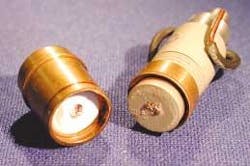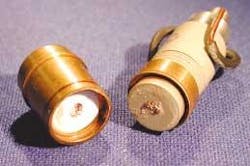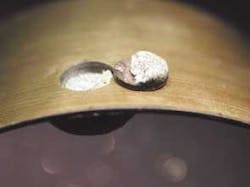Amplified ultrafast lasers move out of the laboratory
Most materials have an electron-phonon coupling time of between a picosecond and a nanosecond with typical heat-diffusion times of a nanosecond to a microsecond.1 Interactions between light and matter that are shorter than the time required for heat creation and conduction mechanisms to occur are termed "ultrafast" (UF). Femtosecond, and sometimes picosecond, laser systems interact with materials by means of a multiphoton nonlinear interaction instead of via conventional linear absorption in which the light and matter interaction is characterized by the materials' absorption coefficient at the laser wavelength. Ultrafast material interactions are characterized by negligible heat-affected zones (HAZ). This nonthermal interaction is what makes ultrafast laser systems so valuable in most ultrafast applications. Other applications simply take advantage of the shortness of the laser pulse in various ways.
Amplifier architectures
Most applications for amplified-ultrafast (AUF) laser systems are in the early adoption phase of the product life cycle. No single amplifier architecture has emerged as the universally superior choice because one architecture can be more suitable than another for a given application. The three most prevalent laser-amplification architectures in commercial ultrafast systems are regenerative amplifiers (RGA), multipass amplifiers (MPA), and RGA/MPA combinations. Key ultrafast-amplifier considerations include tolerated system complexity (required reliability), required output-pulse duration, required output-pulse energy, required contrast ratio, seed oscillator input energy, acceptable amplified spontaneous emission, and cost/price constraints.
Regenerative amplifier-only architectures are generally reserved for ultrafast systems with lower output energies in the one and sub-one millijoule-per-pulse levels at 1 kHz. Higher energy systems typically add a multipass amplier to the output stage of an RGA to obtain output energies of more than 1 mJ and can deliver greater than 3.5 mJ per pulse and higher at repetition rates of 1 kHz. Some RGA/MPA combination systems have the higher gain necessary to compensate for losses from the spectral shaping required to allow the same amplifier to operate in either the femtosecond or picosecond regimes. The ability to run an amplified system at either femtosecond or picosecond pulse durations greatly enhances the system's utility. Multipass amplifier-only architectures are used when extremely short pulses are required—1.5-mJ pulses shorter than 35 fs at 1 kHz, for example. Their design makes it simple to calculate all dispersions and to nearly perfectly compensate for them. These systems are also simpler and less sensitive to thermal lensing and therefore provide excellent beam quality.
A typical picosecond laser system can be based on a double-pass amplifier and deliver 125-mJ pulses of less than 60 ps at 20 Hz with a solid-state saturable-absorber-based oscillator without messy liquid dyes or toxic solvents. Some advanced designs also incorporate serrated aperture relay imaging to eliminate unwanted diffraction effects from the amplifier, which prevents damage to downstream optical components.
Applications
Current amplified-ultrafast-laser applications fall into one of four categories: materials processing, repair, imaging, and metrology.
Stent manufacturing. Femtosecond laser micromachining provides the only process currently available to cut the intricate mesh patterns required for making new intracranial stent designs from small Nitinol (a shape-memory alloy) tubes.2 Stroke is the leading cause of death and a major cause of disability today. Ischaemic stroke occurs when a blood clot or a dislodged piece of atherosclerotic plaque lodges in an artery and reduces or totally occludes blood flow. Minimally invasive procedures such as the placement of an intracranial stent offer great hope for the effective treatment of stroke by opening up stenosed vessels or to act as a brace for the treatment of aneurysms.
The size of currently available stents, however, limits their usefulness. Very narrow and fragile cranial arteries, together with the tight curve of the carotid siphon, prevent the use of most coronary stents in the brain. Current designs are only able to reach 10% to 15% of the vessels in the brain. There is now a weak penetration of the estimated $3 billion annual market for interventional devices to treat stroke and stroke-related conditions of the brain.3 New stent designs induce minimal contact stress with artery walls, provide maximum elastic recoil, and are typically 1.5 to 3 mm in diameter. A negligible HAZ and excellent cut-edge quality make ultrafast systems ideal for this application.
Cutting high explosives. Amplified-ultrafast-laser systems are an invaluable tool for cutting high explosives in initiation physics according to Jerry Benterou, a research engineer in the Femtosecond Laboratory, High Explosives Application Facility at the Lawrence Livermore National Laboratory (LLNL; Livermore, CA). Initiation physics is the study of detonation physics and the initiation of an explosion. The nonthermal cutting of an ultrafast pulse is essential to cutting a high explosive without detonating it (see Fig. 1). The explosives are cut into small pieces and surrounded by a multitude of instruments, including interferometers, to study the detonation velocities, powers, and other properties of the detonation phenomena. Explosives studied include TNT, Composition B, HMX, HNS, PETN, and RDX. They are used in conventional weapons, in the detonation train for nonconventional weapons, or in smart bombs.
Demilitarization. The dismantling of old and outdated missiles and bombs is another materials-processing application that benefits from the unique properties of ultrafast pulses. Old missiles that date back to the 1960s have metal skins that are only 1 to 2 mm thick. These can be cut apart safely and rapidly with current commercial energetic amplified-ultrafast-laser systems (see Fig. 2). The union of two technologies—robotics and ultrafast lasers—is accelerating demilitarization, according to Jerry Benterou of LLNL where early work in this area is under way. The safety and economy of demilitarizing old munitions with robotics and lasers is preferable to exploding the old munitions, as has been done historically. Another advantage of using ultrafast-laser systems is that the propellant of old munitions can be reused, creating less hazardous waste and pollution.
Photomask repair. The manufacture of semiconductors requires a photomask for each photolithographic process, each of which can cost between $5000 and $50,000. Prompt repair of these photomasks is crucial to keep a semiconductor fab running. Photomasks typically use chrome on quartz glass and the newer phase-shift masks are also amenable to ultrafast-laser processing. The two major advantages of ultrafast lasers for photomask repair are the minimal HAZ that enables them to repair masks with feature sizes down to 0.15 µm and the resulting high post-repair photomask transmission.4 Small-design-rule photomasks have intrinsically low light transmission. A 100-fs system can process a mask and keep the photomask transmission greater than 98% because of minimal mask glass damage. In one instance, a 200-fs system processed a photomask resulting in 95% post-repair transmission (too low to use), whereas a 100-fs system repaired the same photomask and maintained a light transmission of more than 98%.
Medical imaging. The development of a reliable optical biopsy has been an elusive goal for some years. Researchers at the Institute for Ultrafast Spectroscopy and Lasers, The City College of the City University of New York, (New York, NY), developed and are refining a technique in which transilluminated two-dimensional images of biological tissues are recorded using an ultrafast electronic-gated imaging camera system. This time-sliced imaging arrangement typically uses 120-fs pulses at a 1-kHz repetition rate from an ultrafast-laser system. In one study on the parotid (salivary) gland, the images that were recorded with the earlier temporal slices (approximately the first 100 ps) of transmitted laser light highlighted the tumor, while those images that were recorded with later temporal slices (later than 200 ps) emphasized normal tissues.5 The differentiation arises from the differing scattering and absorption characteristics of normal and malignant tissues. This technique shows great promise for the noninvasive detection of abnormal tissue or cancers in the breast, brain, gastro-intestinal tract, prostate, skin, salivary glands, arteries, and bones. Together with spectroscopic imaging, this time-sliced method could provide much more information than even x-rays.
Satellite and lunar ranging. The McDonald Laser Ranging Station (MLRS) at the McDonald Observatory (Fort Davis, TX) is a dedicated laser ranging station capable of measuring round-trip light travel times to a constellation of artificial Earth satellites, including two GPS satellites, and lunar retroreflectors to a precision of about 1 cm.6 Information obtained is also used to provide high-precision orbits for these satellites. This installation is a fundamental station in the worldwide laser-ranging network and consists of a 0.76-m reflecting telescope and an amplified picosecond frequency-doubled Nd:YAG laser with associated computer, electronic, and timing hardware. By comparing a series of measurements over a 30-year period, together with a 10-year history of data collected on ranging artificial satellites, one can obtain scientific information in the four broad areas of solar system ephemeris development, general relativity and gravitational physics, lunar science, and geodynamics. The MLRS is the only lunar-capable ranging station in the United States and one of only two in the world.
Outlook
Different applications are clearly placing differing requirements on amplified-ultrafast-laser systems. The scientific market is still demanding shorter pulse durations at higher energies. For most industrial applications beam quality, system cost, and system reliability are more important factors than pulse duration. Industrial systems seem to be perfect candidates for incorporating a lower-cost and more-rugged fiber-laser seeded-amplifier configuration. Widespread use of ultrafast systems for medical imaging will require some innovations to make energetic femtosecond systems cost-effective. "As AUF laser performance improves and system prices decrease, the applications will open up, especially in the area of weapons demilitarization," says Jerry Benterou of LLNL. "The next large market that I see coming for AUF laser workstations is LCD-mask repair," says Jon Heyl, executive vice president of sales and marketing for Control Systemation (Orlando, FL).
REFERENCES
- Brookhaven Natl. Lab., Inst. Div., Ultrafast Lsr. Lab., www.inst.bnl.gov.
- Liming He, Mgr. of Ultrafast Apps. Lab., Quantronix, pers. comm. (2003).
- Interventional Neurorad., Stroke & Carotid Artery Stenting (Aug. 10, 2000).
- Greg Anderson, president, Control Systemation, pers. comm. (2003).
- S. K. Gayen et al., IEEE J. Sel. Top. in Quant. Elec. 7(6) (Nov./Dec. 2001)
- Annual Report, Univ. Tex. McDonald Observatoary & Dept. of Astro. (Sept. 2001/Aug. 2002).
MARK V. ORTIZ is vice president of sales, marketing, and business development at Excel Technology, East Setauket, NY; e-mail: [email protected].


